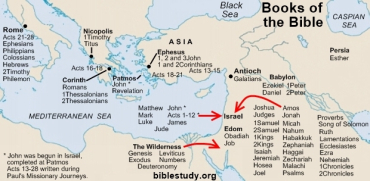The originally inspired order of books was set by Ezra the prophet (for the Old Testament) and the Apostle John (for the New Testament). Many years after John died, however, their arrangement was changed. Who changed the inspired arrangement of the Bible? Why did they do it?
The Work of Ezra
Ezra divided the books (manuscripts) of God's word that compose the Old Testament into three major divisions. These divisions are called the Law, the Prophets, and the Writings (or Psalms). Jesus Christ validated this order of Scripture when he said the following.
These are the words which I spoke to you while I was still with you, that all things must be fulfilled which were written in the LAW of Moses and the PROPHETS and the PSALMS (or Writings) concerning Me (Luke 24:44).
How did Ezra arrange the Old Testament manuscripts? The first section, the Law, contained the books of Genesis, Exodus, Leviticus, Numbers and Deuteronomy. The second section, the Prophets, contained Joshua and Judges (considered one manuscript), 1 and 2 Samuel, 1 and 2 Kings (one manuscript), Isaiah, Jeremiah and Ezekiel. It also contained one manuscript composed of the writings of all twelve of the Minor Prophets.

The final section of the Bible, called the Writings (or Psalms), contained the Psalms, Proverbs, Job, Song of Solomon, Ruth, Lamentations, Ecclesiastes, Esther, Daniel, plus Ezra and Nehemiah (one manuscript), along with 1Chronicles and 2Chronicles (one manuscript). The Old Testament was originally inspired to have three main sections with a grand total of 22 manuscripts (one for each letter of the Hebrew alphabet).
The Final Task
God gave the final task of collecting and canonizing the New Testament to the apostle John. In the period between 96 and 99 A.D., John, as the last living disciple of Christ, arranged the manuscripts he had into four main divisions. The first division, the Gospels, contained Matthew, Mark, Luke, John and then Acts.
Following the Gospel division came the General Epistles, which had the writings of James, 1Peter, 2Peter, 1John, 2John, 3John and Jude. The next section contained all the writings of Paul in the following order: Romans, 1 and 2 Corinthians, Galatians, Ephesians, Philippians, Colossians, 1 and 2 Thessalonians, Hebrews, 1 and 2 Timothy, Titus and Philemon. The final section contained Revelation.
God originally inspired his Word to have seven divisions with a total of forty-nine (seven times seven or perfection multiplied perfectly) manuscripts. This is vastly different from modern translations of Scripture (like the KJV, NKJV, NIV, etc.) which have no divisions, no logical arrangement of manuscripts and contain 17 more manuscripts than what was intended!
Who Changed the Order?
It was the fourth-century priest Jerome (c. 347 to 420 A.D.) who rearranged Scripture to what we have today. He changed the inspired original order of God's word for political and ecclesiastical reasons.
". . . the (modern) Old Testament books are arranged in an ECCLESIASTICAL order devised by Jerome in the fourth century A.D. when he translated the Bible into Latin . . . (he) did not wholly follow the inspired order of the books according to the final canonization by the high priest Ezra and the Great Assembly . . .
"Instead, he chose to follow the order found in the Septuagint, an early Greek translation of the third century B.C." (HBFV, Second Edition, page 1)
"In an attempt to exalt the religious and political position of the Roman Church, Jerome not only REJECTED the original order of the Scriptures to follow . . .
"the LXX (another name for the Septuagint), he also single-handedly devised a "new" arrangement of the books of the New Testament" (ibid. page 3).
Does it Matter?
Does the order of books matter? It mattered enough for Ezra and others to spend countless hours laboring to canonize the Old Testament. It mattered enough for the apostle Paul and Peter to dedicate the time to finalizing their writings so that many others could learn about God's way. Lastly, it mattered to Jesus who, in his very first appearance to the disciples after his resurrection, reminded them that the three-fold inspired testimony of the Bible concerning him had to be fulfilled.